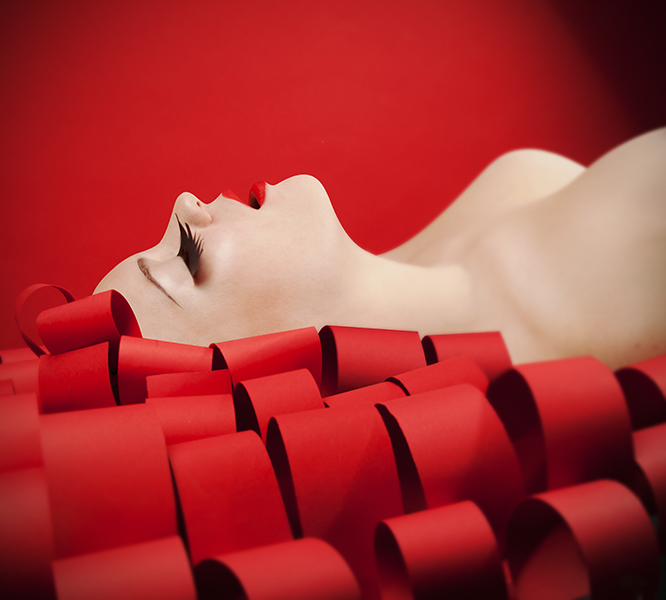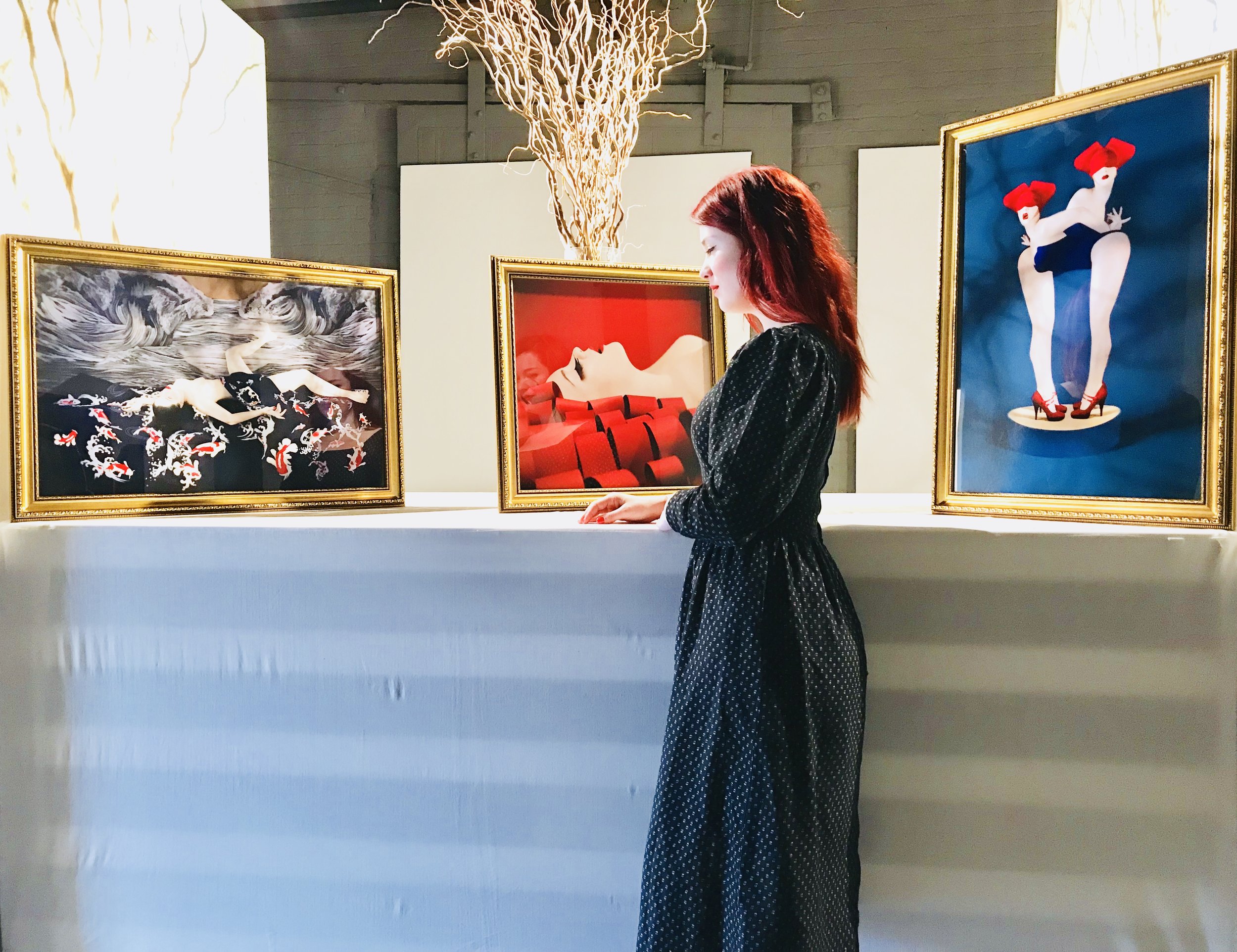French artist Nathalie De Zan manipulates the body in surrealist "mise-en-scènes”
Born in Toulouse, Nathalie De Zan has been a multimedia artist for eight years. Although her preferred medium is photography, for achieving her aesthetic ends she uses all manner of media in her creative process: video, graphic design, music, scenography, clothing, origami… She works essentially on the bodily links to space and to intimacy in provocative and dreamlike settings. For her the body is a way of elaborating analogies between artistic and physical processes. The aim is to question the status of the body in the face of diverse pressures of our modern world. She creates syncretic chimera aided by metaphor, and by symbols that she is constantly questioning.
There is art
There is art, inscribed on all the domes of the world, engraved in marble: Sculpture, Painting, Engraving and Architecture; and now with Nathalie De Zan there is the Pure Body. Purity of a frozen moment, a moment bound by invisible silk ropes, tied to disappearing and unnoticeable velvet chains. An undetectable and elusive bondage by way of the quixotic curling ribbon, unmoored and unpunishable, A faceless bondage that ensures and assumes and liberates the body. By hiding the face whose disturbing countenance would direct our eyes, we clearly distinguish an erotic suspension, a naked and avowable gesture, in which all the curves spring into a space with mysterious radiance. An impassioned body of great beauty, glorious, sumptuous and flamboyant, it evokes the pagan goddesses and that most majestic human being: woman. A body neither altered nor adjusted in its essence, a lone digital caress that brushes the photographic grain, for it is also photography. The framing and mounting become a hymn to the mysterious character of femininity. Undetectable gymnastic and geometric figures balance themselves in a living dance, stabilizing then seeming to rest. Under this anonymity, one reveals all of the body, an idol, an airy corpus whose constraints of gravity beget the problematics of the pedestal that never disappears.
It is a masterly and fleeting symphony, Beethoven’s tenth that was never written, never composed except here before our eyes. Here one sees and listens to this fulfilled body which satisfies and nourishes itself with forbidden Pleasure. A lone vein of light oscillates over the prints and excites our eyes, a roaring flame, incandescent hair. This nebulous main, does it belong to Red Hair, that emblematic and imaginary heroine, the faithful fighter at Storm’s side? A tempest with ivory legs, muscles tensed and rested like those of a stripped Barbarella. An accomplished warrior, she seems to be in a state of bliss befitting a romantic amazon. Our most stigmatised, disavowed dreams falter in front of the exhibition of the vertiginous pelt, with not one stray hair, a hymn to joy, to abandonment. This striking self-exposure under a blaze of light transmutes the body into a dazzling portrait and makes the corpus sparkle in its erased identity. The secret of feminine anatomy is thus revealed to us. A photographic moment of amorous movement, of assembled flesh and evanescent skin push us to face a confusing eroticism, a true fatal illusion of pale colours that by means of electronic filters create a faded retro perspective. Whether the filters are photographic or amorous, they seduce us, woo us, bewitch us. A mischievous Cokin filter exposes an erotic ritual whose vibrations are as much electroconvulsive as scorching our skin. There is also a Lynchesque cinematographic strangeness, again this frozen moment that seems to tremble with mystery and emotion. Whimsical and nimble, the chains and the strings disappear and it is our desires, our cravings, our fantasies that fasten, attune, tie up, bind, tighten, for conquering and seducing this steadfast body. This astounding body that undulates and sways between earth and air, between air and sea. A delightful levitation sacrifices and exalts the body, pounding it with the personified praise of forgotten idols. As the Etruscan Goddess Thesan, Nathalie de Zan fuses fantasized fertility and an unrestained sexuality like a huntress of invisible wild animals. In such an unrestrained nature, virginity has no place. Aphrodite mates with Persephone and gives birth to a vegetative nature with the most carnal senses. There is magic in these bodies that are suspended, or rather hung, on intangible gallows, by an elusive executioner. This body, at least in the forms of the idol of Bastet, the cat goddess, or Hathor, symbolizes the principles of love, running aground on a beach of smooth sand near Sothis, fertilizing the soil. An assemblage of organs, of anatomic substance, the praise of feminine happiness, a fantasy of the attached self, is subjected to the moods of the evil spirit, masculine and feminine. A body moved and manipulated by order of an invisible and perverse choreographer, raising our most unfathomable questions, our most enduring doubts. Unified forms, mixed with corporeal and fluid abstraction, taking pleasure in an ecclesiastical nudity. In praise of feminine happiness, like an ancient statuette, Poetess and witch of a thousand rainbows, this idol eliminates chastity and becomes a totem, a trophy.
The silent pause of the photograph subjugates the model as a liberated slave before a viewer with the master’s gaze, this dominating lover, this Amphitryon philosopher. No possibility of touching or caressing this body suspended from an imaginary gallows. Is it pleasurable? Dominated by action, who enslaves and who subjugates? Who is the slave? The answer is certainly in the top corner vision where the lust of the sculptor, painter, engraver and architect resonates. The pure body with pupils both thoughtful and troubled, it is an indisputable statue, a caryatid of spirited and sumptuous sins, a new allegory of freedom, even though she is suspended… she triumphs.
Sid Poliakov / Translation by Carolyne Lee



